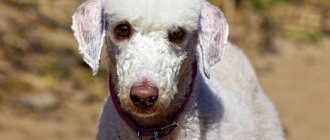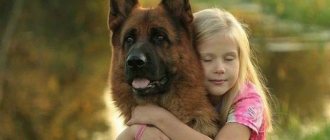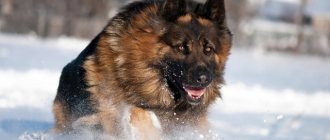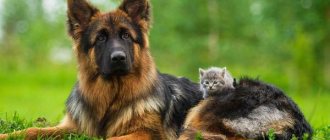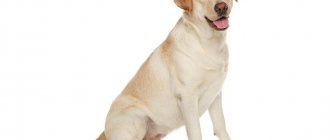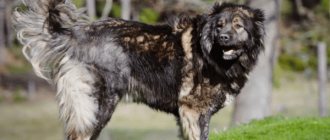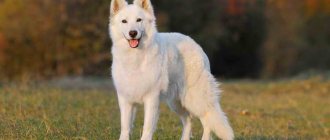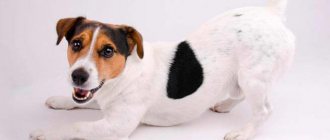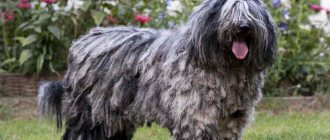- Reports
- Animals
- German Shepherd
The German Shepherd is a very common breed of dog. The main purpose of the German Shepherd is for exhibition purposes, it is an indispensable service friend in the police and the Ministry of Emergency Situations, and shepherds are also favorites in the home family circle.
This breed appeared in the 19th century. The main task of such dogs was to protect herds of animals. Thanks to its high endurance, stable, balanced psyche, and strong sense of smell, this dog began to be trained and used for police purposes and in the army.
During the years of the First and Second World Wars, this breed of dog showed itself properly and became man's best friend.
Currently, the German Shepherd is indispensable in the household; it ranks first among all dogs and is not inferior to any breed in competition. The German Shepherd is a unique and very intelligent dog. She can equally serve in the army, be a partner to a policeman, save people in case of fire and in the event of collapses and buildings, find drugs, guard a house, or accompany the blind and be a nanny for small children.
Despite the fact that German Shepherds are very strong and hardy, they are prone to certain diseases, namely joint diseases, eye diseases and allergies.
German Shepherds come in both smooth-haired and long-haired varieties. The coat color is different - black, red-brown, light gray, yellow-brown.
When entering a family, the main thing for a dog is to become loved and ideal for its owners. Dogs of this breed seem to take very good care of small family members and their safety. The devotion of these shepherds has more than once saved the lives of children when they were attacked by criminals. These dogs can also take good care of pets, such as cats. Shepherds love company very much; this breed of dog experiences loneliness very difficult - it howls and whines like a wolf, demanding attention.
Since the German Shepherd is a large breed, it can pose a danger to people. To avoid this, and for people to feel comfortable living next to such a dog, it needs to be trained. Shepherds are very smart and cunning animals, they are easy to train. A trained dog will never just attack people, but in case of danger, it will detain a criminal on command.
German Shepherds are a wonderful pet for kind and active people who appreciate the affection and love of their owners.
Origin of the word shepherd
The Shepherd is a fairly common breed whose name is well known to everyone. But where did the word “shepherd” come from? If you look at the history of the German Shepherd breed in detail, you will understand that it got its name for a reason. In ancient times, sheepskin was the name given to processed sheep skin. Therefore, this word gave the name to individuals who tended flocks of sheep and protected them from wild animals and people who might covet the cattle. By the way, the ancestor of the breed was the Hofowart, which came from crossing an ordinary European dog and an Indian wolf, which is a predatory animal.
Indian wolf
In general, these animals began to be mentioned in historical sources around the 16th century. It was written about them that they are quite powerful and strong dogs with a death grip. It’s not for nothing that their ancestor was a predator.
Nuances of care
German Shepherds are unpretentious and are best suited for keeping in an outdoor enclosure.
However, if you plan to keep your pet at home, then provide it with the following conditions:
- make sure there is enough daylight in the room;
- lay rugs on all slippery surfaces (parquet, tiles, linoleum) - this will protect the puppy from developing an incorrect gait;
- hide all visible wires, household chemicals and everything that the puppy can accidentally eat, harming itself;
- Brush your pet twice a week with a slicker brush. During the molting period - every day;
- clean your ears of wax once a week with a napkin or sponge;
- take timely preventive measures to combat fleas and other parasites;
- Give your pet a special chewing bone with fluoride once or twice a week to prevent the formation of tartar;
- Treatment for worms should be carried out once every three months, at the rate of 1 tablet per 1 kg of weight. Suitable drugs: Cestal +, Drontal +, Konikquantel and Azinox. Deworming is necessary 10 days before vaccination;
- vaccination is carried out at 4, 8 and 12 weeks;
- A German Shepherd living outdoors should be treated for shingles.
IMPORTANT!
If a dog often scratches its ear, shakes it, and dark brown traces of wax remain on the sponge, it means the dog is suffering from an inflammatory process or ear mites.
First attempts at selection
Why did the dog become known as the German Shepherd? The number of German Shepherds began to increase increasingly in German cities in the 18th century. The thing is that at that time sheep breeding began to develop rapidly. People raised sheep, goats, horses and pigs. Accordingly, more and more dogs were required to herd and protect them, because there were at least two individuals per dog.
The fact that the breed appeared in Germany influenced its name. But it was far from perfect, so farmers tried to improve the functional qualities of its representatives.
Such dogs were bred in two districts of Germany. These were southwestern Thuringia and Württemberg. Of course, the animals differed in their disposition, character, and appearance:
- The shepherd dogs of southwestern Thuringia were quite active, sometimes even angry. They had an average build with not long and not thick hair. The fur had a darker color that was similar to that of a wolf. The dogs had long erect ears.
- The dogs of Württemberg, in comparison with their counterparts from Thuringia, on the contrary, were more balanced and had a calm character. They had thick and long fur, and their color was black and red. These dogs had drooping ears and a large build.
In the nineteenth century, German Shepherds began to be mixed with other breeds of herding and cattle animals. For example, with such early bred dogs as: collie, moody, welsh corgi. By the way, here you can read interesting material about raising and training a German Shepherd.
Appearance
What does the animal look like? Breed standard.
The head is wedge-shaped, with a long face. Nose is black. The eyes are medium-sized, almond-shaped, set slightly obliquely, not protruding. The color is dark. The ears are straight, medium-sized, parallel, cone-shaped. Powerful mouth with a scissor bite. The upper incisors closely overlap the lower ones. The teeth are strong, light, there are 42 of them.
— Advertising —
The neck is strong, muscular, neat and relatively long. It is proportional in size to the head, without loose folds of skin. The back is straight and well developed. The chest is moderately wide and deep. Forelegs: shoulder blades long, sloping, placed flat. When viewed from all sides, the legs are straight. The hind legs are parallel, with muscular thighs. The tail should reach at least to the hock joint.
Males are usually larger than females. The normal weight of individuals is 22-40 kg, height is 55-65 cm.
The breed has a thick double coat of coat that protects from the elements. The outer coat is harsh, while the undercoat is fluffy, soft and dense. The head, inner ear and forehead, as well as the legs and paws are covered with short hairs. The neck comes with longer and thicker hairs.
— Advertising —
Most common colors:
- Black.
- Black and red.
- Sobolinaya.
- Brown.
- Rare: gray color.
Black and zoned are special names for popular coat colors.
Where was this breed developed?
The very first exhibition at which individuals of this species participated and were shown took place in 1882 in the German city of Hanover.
Then the breeders announced that they had bred dogs with new qualities. It was a male and a female. They were given the nicknames Pollux and Prima. The dogs looked like wolves, but at the same time they were calm and psychologically balanced. They originally came from Thuringia. Dog handlers became seriously interested in these dogs; the bitch and the male aroused interest among dog breeders due to the combination of a developed guard instinct, endurance, and obedience.
Nutritional Features
There is no consensus among breeders regarding feeding German Shepherds. Some prefer natural, balanced food, while others prefer ready-made industrial super-premium or holistic class food.
However, there are general rules for creating a diet that should be followed to maintain the health and stamina of the dog:
- Protein is the basis of the diet. 70% of products should contain animal protein - meat, milk, eggs. Be sure to check the composition of the feed;
- fats and carbohydrates make up the remaining 40%. Cereals, vegetables, fruits, vegetable and animal fats;
- for an adult dog, food intake should be strictly scheduled twice a day;
- After a meal, the bowl should be washed immediately - this should accustom the dog to a regime without snacking and begging;
- if the dog lives on the street, the food should be heated to warm, room temperature.
Max von Stefanitz and breeding a different type of dog
At the end of the 19th century, an important event occurred in the history of the German Shepherd. The military man Max Emil Frederick von Stephanitz, being an expert in this field, became interested in shepherd dogs and decided to breed a different type of breed that did not exist before.
He knew almost everything about the representatives of this breed, which helped him achieve significant success in this matter. In addition, he had a veterinary education. The man believed that it was possible to combine in a shepherd dog not only high endurance, the ability to work until exhaustion, and a strong character, but also good ability to learn commands and the ability to obey a person.
In the spring of 1899, von Stefanitz bought a male dog at a dog show, to whom he gave the nickname Horand von Grafrath. He registered it as a new specimen of the breed. This dog looked like a wild wolf. But the breeder said that such dogs could become the basis of a new breed, including the best, but difficult to compatible qualities. However, other breeders thought differently. They said that wolf-like shepherds were not the dogs that could become the basis of a new breed. But the male became the progenitor of the modern German Shepherd. And the baron was the one who bred animals not for his own selfish purposes, but purely out of love for the breed.
Foundation of the union
That same year, von Stephanitz and his close friend Arthur Mayer created the German Shepherd Society in Wendsbeck. They traveled to different cities in Germany and looked for bitches that they thought were healthy and promising animals, and could serve as the basis for the continuation of a new breed. In addition, friends and their colleagues created their own selection standards, which included parameters of the breed’s performance, while retaining some of the previously formed standards. Thus, a huge breeding work was carried out.
In addition, Max von Stefanitz came up with 6 main rules for creating a new breed, which modern breeders should follow:
- Creativity is almost never combined with profit. Therefore, when breeding new breeds, it is necessary to do this out of great love for animals, and not for money. At the same time, it is possible to control the entire development process only if there is a huge amount of time devoted to work.
- To create a high quality breed, it is necessary to use only dogs that are physically and psychologically healthy. An animal must be raised and raised not only with the owner, but also in his absence.
- Saving money on the health of the animal is strictly prohibited, as is breeding purely champion dogs.
- It is worth choosing females and males not so much from champion lines, but from healthy and proven ones.
- Shepherd dogs that have suffered a serious illness or psychologically unstable individuals are not suitable for further breeding.
- It is not advisable to interbreed close relatives. This may have a negative impact on the quality of the breed.
Boy
The average weight of a male is 30-40 kg, height is 60-65 cm.
The male is taller, larger and heavier than the female. It has a large head and a wider body.
Males love to dominate, they are proud, while females are more affectionate and gentle. Males are also more territorial towards their home, yard, property and owners.
He prefers to communicate with his authority figure, who spends the most time with him. Despite the fact that he loves every member of his family.
Because males like to dominate, their training can be more challenging.
Boys will need more food than girls due to their larger size.
How a shepherd became a service dog
Since the working qualities of the individuals were very important, it was necessary not to leave the dogs without work. At the same time, the number of pastures began to decline sharply. Therefore, Max von Stefanitz began to look for other options for using representatives of the breed. He suggested using animals for police service. The dogs quickly got used to their new responsibilities and became good helpers in law enforcement. Soon the military recognized the German Shepherd as a dog capable of serving in the army.
1901 can be considered the first year of service of such dogs in the German armed forces.
Sheepdog in World War II
In April 1936, Max von Stefanitz passed away. But his business did not die. It continued thanks to the efforts of the veterinarian's colleagues and friends.
During the Second World War, most of the shepherd breeding organizations ceased to exist. But like-minded people of von Stefanitz managed to save the breed from extinction, promptly restoring the number of dogs in the post-war years.
The first exhibition after the war was held in 1946, where it was decided to create a selective class to increase the base of the best representatives of the breed. Also read our article on feeding your German Shepherd.
Division of dogs into high and working breeding
In the 60s, two lines appeared in the breeding of the breed: high and working breeding. Working breeding is based on the physical, athletic qualities of the dog, while breeders pay less attention to the aesthetic appearance of the animal. Participation in competitions is important, as well as the compliance of representatives of the breed with indicators of physical activity, balance and absence of diseases.
The high or show direction is guided, in addition to the physical condition of the animal, by the standards of the dog’s exterior. These are the animals that take part in exhibitions.
German Shepherds in the USSR after the revolution and during the Great Patriotic War
In the post-revolutionary years, a large number of dogs were brought to the Soviet Union for the activities of the People's Commissariat of Internal Affairs and border troops. But the imported animals turned out to be not quite the same as they were before the crisis in cynology. A crisis occurred in Germany in the 20s, when unscrupulous breeders, in pursuit of profit, without giving due importance to the quality of the shepherd breed, crossed them with other dog breeds. They thought only about their own benefit and often did not monitor the health of the animals. In view of this, the dogs had obvious defects in psychological education: they were either cowardly, or, on the contrary, too angry. There weren't many good dog handlers in the USSR, which made it difficult to breed a breed that meets Western standards.
After the Second World War, there were very few dogs left, brought by the fascist invaders. On the other hand, the government received instructions to breed animals for their further use in the army. It is important to note that the breeders faced some mental difficulties. After the war, people had bad associations with the word “German”; the shepherd was considered an enemy animal. In addition, they guarded the camps.
Selection and cost of a puppy
The price of purebred German Shepherd puppies depends on the class and their pedigree history.
Ordinary puppies intended for protection and watchdog activities cost from 15 to 30 thousand rubles.
If you decide to start breeding dogs, a good sire or purebred bitch will cost you 45-70 thousand rubles.
For the future champion, a puppy of the most prestigious “show class”, you will have to pay from 50 to 90 thousand rubles.
Important: before purchasing a puppy, ask the breeder for information about who his parents were, their habits and temperament.
The appearance of the East European Shepherd in the USSR
In 1946, it was decided to name the breed not German, but Eastern European, in order to remove negative associations from the name. Contact with Germany was lost, making it difficult to maintain Western breed standards.
But gradually the breed began to recover and improve. This happened in the 80s. Dog handlers brought a purebred purebred shepherd dog from Germany. But only 10 years later it was possible to restore the breed and bring it to the Western standard.
German Shepherd in modern Russia
Today in the Russian Federation there are many clubs specializing in breeding this breed. They all breed purebred dogs and improve the breed. In total, there are about 34 clubs and nurseries in Russia. They operate in cities such as Moscow, St. Petersburg, Novosibirsk, Tula, Krasnoyarsk, Vladivostok, Rostov-on-Don, Kaluga, Podolsk, Voronezh.
Representatives of the breed are used by border troops and the police to search for people and detain criminals, as well as for carrying out operational work. Thanks to its sense of smell, the animal easily finds narcotic and explosive substances and is used in anti-terrorism activities. German Shepherds occupy the leading place among working dogs. Also learn about German Shepherd diseases and vaccinations on our website.
In conclusion, let’s say that German Shepherds are very popular in Russia. The circle of amateurs and professionals is constantly expanding. They organize various exhibitions and competitions and share their experience. More and more breeding clubs are opening. German Shepherds from Russia are even sent to serve in the armies of other countries, which means that they are highly valued there too. When breeding German shepherds in the Russian Federation, greater attention is paid to the working and physical characteristics of the dog. See the addresses of nurseries in Moscow and Moscow Region here.
average life expectancy
The average lifespan of a dog of this breed is from 10 to 15 years.
NOTE!
The better the living conditions for a dog, the longer the pet maintains a cheerful state of mind and physical strength.


